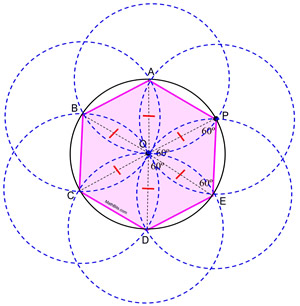How To Draw A Hexagon Inscribed In A Circle
| | Use only your compass and straight edge when drawing a construction. No free-hand drawing! |
Regular Hexagon
(inscribed in a circle)
| | A regular hexagon is a six-sided figure in which all of its angles are congruent and all of its sides are congruent. |
| Given: a piece of paper |
STEPS:
1. Place your compass point on the paper and draw a circle. (Keep this compass span!)
2. Place a dot, labeled P, anywhere on the circumference of the circle to act as a starting point.
3. Without changing the span on the compass, place the compass point on P and swing a small arc crossing the circumference of the circle.
4. Without changing the span on the compass, move the compass point to the intersection of the previous arc and the circumference and make another small arc on the circumference of the circle.
5. Keep repeating this process of "stepping" around the circle until you return to point P.
6. Starting at P, connect to each arc on the circle forming the regular hexagon.
| | Full circle view: |
![]()
Proof of Construction: PA = AB = BC = CD = DE since these lengths represent copies of the radius of circle O. But how do we know for sure that the last length, EP, coincided exactly with point P? Is EP actually the same length as the other copied radii?
ΔDOE is an equilateral triangle since it has 3 sides of equal length (DO and OE are radii lengths and DE is a copy of this radii length). In similar fashion, ΔCOD, ΔBOC. ΔAOB and ΔPOA are also equilateral triangles. Since the interior angles of an equilateral triangle each contain 60º, m∠COD = m∠BOC = m∠AOB = m∠POA = m∠DOE = 60º. Since all of the central angles (surrounding a point) must add to 360º, we know the m∠POE = 60º (360º - 300º = 60º).
Since ![]() we have ΔDOE
we have ΔDOE ![]() ΔDOE by SAS. By CPCTC,
ΔDOE by SAS. By CPCTC, ![]() and we know that the last copy of the radii coincides with point P making the hexagon truly inscribed. Hexagon PABCDE has all vertices on circle O, has congruent interior angles (each equal 120º) and has all sides congruent. PABCDE is an inscribed regular hexagon by definition.
and we know that the last copy of the radii coincides with point P making the hexagon truly inscribed. Hexagon PABCDE has all vertices on circle O, has congruent interior angles (each equal 120º) and has all sides congruent. PABCDE is an inscribed regular hexagon by definition.
![]()
NOTE: The re-posting of materials (in part or whole) from this site to the Internet is copyright violation
and is not considered "fair use" for educators. Please read the "Terms of Use".
How To Draw A Hexagon Inscribed In A Circle
Source: https://mathbitsnotebook.com/Geometry/Constructions/CCconstructionHex.html
Posted by: josephouldives.blogspot.com



0 Response to "How To Draw A Hexagon Inscribed In A Circle"
Post a Comment